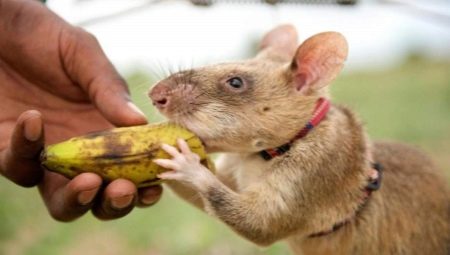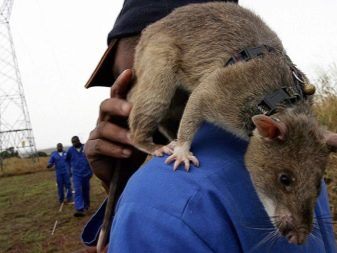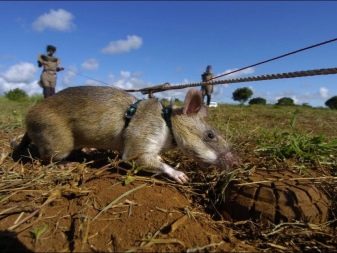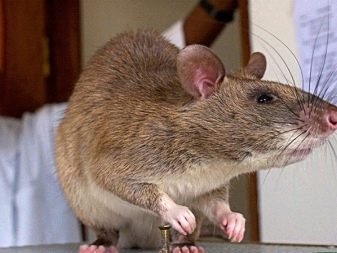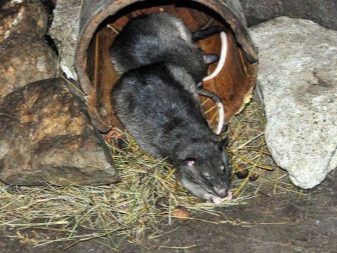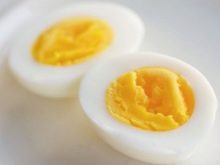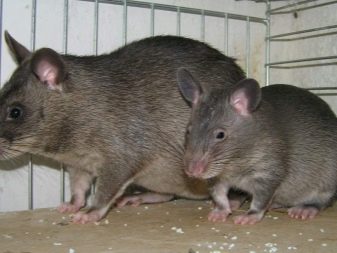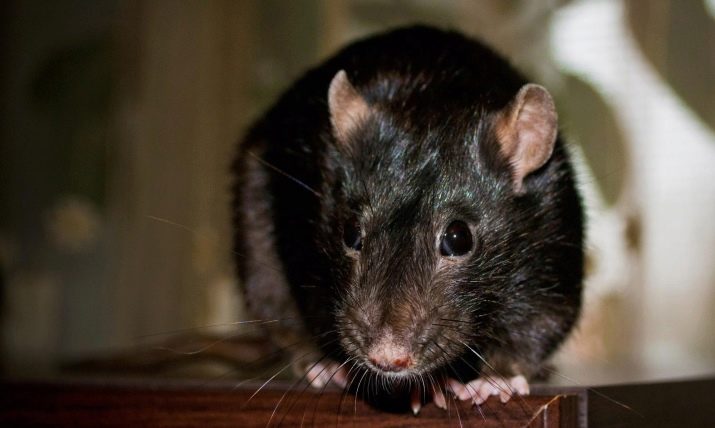The Gambian rat is a very large rodent belonging to the genus of mice. It is also called hamster or marsupial, which is explained by the tendency to hide food in cheek pouches. Thus, rats can tolerate quite a large amount of food. These rodents are unique animals, because they can be trained and taught useful skills.
Rodent description
The body length of an adult Gambian marsupial rat reaches 90 cm, including the tail, which is approximately 40–45 cm. The weight of the rodent is also quite impressive: up to 1.5 kg. Wool coarse, painted in brown or gray shades, while the abdomen is always lighter than the back. Dark circles around the eyes. The ears are large, open, oval-shaped.
Outwardly, it is difficult to distinguish the female from the male, as they have the same features and size.
Since Gambian rats are nocturnal animals, their eyesight is rather weak. But they have excellent hearing and keen sense of smell. These abilities help them to detect not only food, but also mines, tuberculosis bacteria, and so on. When it became known that this species of rodents is well trained and trainable, they began to be caught and bred for personal use. In addition, the animals often become pets, because they are calm, contact and very smart.
Marsupial rats are sensitive to cold, as they have virtually no subcutaneous fat deposits. Heat is also unacceptable for them.
Comfortable temperature conditions vary between 20–25 ºС.
If rodents are provided with proper conditions of detention, they can live 4 years, while in the wild, life expectancy is reduced to 3 years.
Habitat and behavior
Gambian marsupials live in central Africa, and not only in arid areas, but also in forest areas where a temperate climate prevails. Rodents live, as a rule, in burrows, hollows of trees, crevices of rocks and other secluded places. Open spaces they avoid.
Sometimes these unusual animals choose to live in small settlements, and they live not alone, but as a whole family, the number of individuals in which can reach 20.
People suffer greatly from the actions of the caudate neighbors, because they cause great damage to the household:
- eat up supplies in barns and cellars;
- spoil the property;
- clog up the sewer;
- destroy the soil structure;
- promote drying of the nutrient layer of the soil;
- destroy crop sowing.
The hamster rats are most active at night. They crawl out of their hiding places and go in search of food. Rodents carry prey in cheek pouches, the volume of which exceeds 100 ml. In a short period of time they are able to significantly replenish their food stocks. For example, in just 2.5 hours, one individual can carry up to 3 kg of food.
Gambians do not like to encroach on their territory, so they will fiercely defend their nests.
In rare cases, rats can bite, but this usually happens in those moments when they are very scared or trying to show their superiority among their relatives. Rodents never attack first, so do not panic when faced with them face to face.
Captivity
Giant African rats are friendly and have a good-natured disposition. Despite their impressive size, they look pretty cute and if properly educated, then they will behave quite diligently.
Gambian breed rodents love affection and are able to show tender feelings to people, therefore they are often kept as a pet.
That's just the cultivation of such animals in captivity - it is troublesome.
To create a comfortable environment, you need to choose and prepare the place where the rats will live, as well as provide them with good nutrition and care. It is recommended to keep such a large animal not in a cage, but in a spacious enclosure made of metal. It should be remembered that males and females should not live together. The only exception is the period of growing cubs. In this case, their mother should be close.
Since the rodent likes to hide, it is important to equip his house with various loopholes, nooks, hanging hammocks, and labyrinths. It is necessary to refuse plastic and wooden elements, as the pet will easily gnaw through them. The bottom of the enclosure is usually covered with sawdust or dry grass, but wood chip filler can also be used in pellets.
Equipped house for the marsupial rat should be installed in a warm room, and it is desirable that it maintains the same temperature.
The lighting should be artificial, muffled, and direct sunlight should be avoided altogether, because Gambians are nocturnal animals.
Constantly keep the pet's tail locked up can not, you need to walk it every day. In addition, tactile contact with the host is important, so you should take the rodent on your hands more often, stroke, scratch the abdomen and play with it.
Gambians must always have access to food and water, therefore water bottle and feeder should be regularly replenished. In addition, rodents are very thrifty and constantly hide food.
Therefore, if the feeders become empty very quickly, do not worry that the animals are starving, and rush to feed them.
It is advisable to provide them with two meals and closely monitor the size of portions, as they can eat a lot, but overeating is fraught with the development of various diseases.
The marsupial hamster rat is omnivorous, but this does not mean that all food is equally useful for it. The basis of the diet should be:
- vegetables;
- fruits;
- legumes;
- seeds.
Protein, which accounts for about 40% of the food consumed, is important for the health of rodents. If in the wild, Gambians receive protein mainly from insects and mollusks, then at home they are recommended to be fed:
- lean boiled meat;
- low-fat cottage cheese;
- boiled eggs;
- seafood.
As for the forbidden food, it includes fatty, salty, pickled, fried and spicy foods. In addition, you should not give your pet to try carbonated and alcoholic beverages.
Breeding features
As a rule, African marsupial rats breed in summer. But if they live in captivity, and for their comfort all the necessary conditions are provided, then this process can occur at other times of the year. To conceive offspring, the age of the animals must be at least 6 months.
Rodents have a peculiar mating ritual, during which the female and the male first brush one another, then play catch-up, and only after that they mate.
It should be noted that females do not always accept the male's courtship and bite his back or tail as a negative answer.
A gambian rat’s gestation period lasts 30–32 days, and it can tolerate a maximum of 5 cubs. The female after childbirth is very aggressive, so it is better not to touch her once again. Toddlers are born bald, with closed ears and eyes, which will open on days 14 and 21, respectively. As they grow up, their tail grows and their coat appears.
For 28 days, the rat feeds its offspring with breast milk and teaches the young to feed on their own, and at first chooses soft foods for babies.If the female lives in captivity, then she needs to provide a special diet enriched with vitamins and proteins.
And you can also prepare food for rats, which should consist of easily digestible ground products.
Males in no way participate in raising and feeding their cubs, and sometimes even eat them. Therefore, it is necessary to protect him from the newly-minted mommy and newborn rats. Quite often, other females help care for the offspring. At 2 months of life, young Gambians begin to feed on their own and even feed themselves.
Read more about the Gambian rat in the following video.
